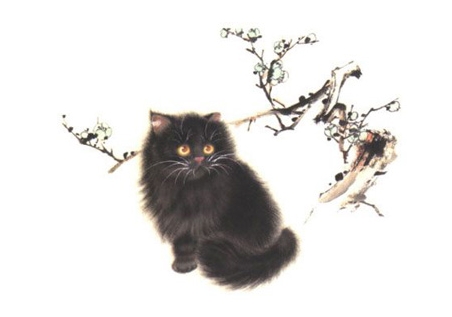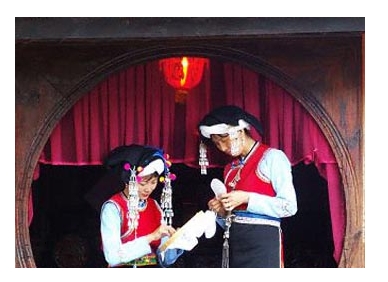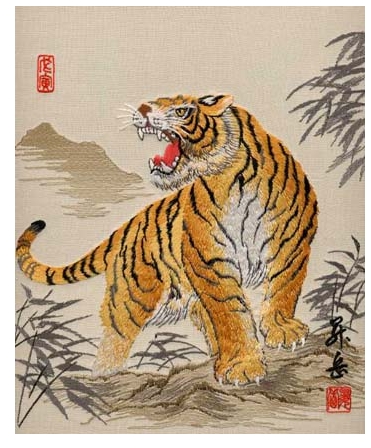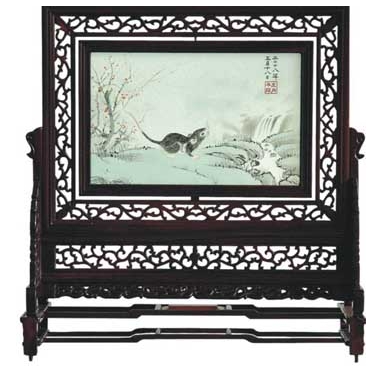Development of Chinese Embroidery
Embroidery is a brilliant pearl in Chinese art. From the magnificent Dragon Robe worn by Emperors to the popular embroidery seen in today's fashions, embroidery adds so much pleasure to our life and our culture.
The oldest embroidered product in China on record dates from the Shang Dynasty. Embroidery in this period symbolized social status. It was not until later on, as the national economy developed, that embroidery entered the lives of the common people.
Through progress over Zhou Dynasty, the Han Dynasty witnessed a leap in embroidery in both technique and art style. Court embroidery was set and specialization came into being. The patterns of embroidery covered a larger range, from sun, moon, stars, mountains, dragons, and phoenix to tiger, flower and grass, clouds and geometric patterns. Auspicious words were also fashionable. Both historic records and products of the time proved this. According to the records, all the women in the capital of Qi (today's Linzi, Shandong) were able to embroider, even the stupid were adept at it! They saw and practiced it everyday so naturally they became good at it. The royal family and aristocrats had everything covered with embroidery-even their rooms were decorated with so much embroidery that the walls could not be seen! Embroidery flooded their homes, from mattresses to beddings, from clothes worn in life time to burial articles.

The authentic embroideries found in Mawangdui Han Tomb are best evidence of this unprecedented proliferation of embroidery. Meanwhile, unearthed embroideries from Mogao Caves in Dunhuang , the Astana-Karakhoja Ancient Tombs in Turpan and northern Inner Mongolia further strengthen this observation.
During the following Three Kingdoms Period, one notable figure in the development of embroidery was the wife of Sun Quan, King of Wu. She was also the first female painter recorded in Chinese painting history. She was good at calligraphy, painting and embroidery. Sun Quan wanted a map of China and she drew one for him and even presented him embroidered map of China. She was reputed as the Master of Weaving, Needle and Silk. Portraits also appeared on embroidery during this time.
As Buddhism boomed in China during the Wei, Jin, Sui and Tang Dynasties, embroidery was widely used to show honor to Buddha statues. Lu Meiniang, a court maiden in the Tang Dynasty, embroidered seven chapters of Buddhist sutra on a tiny piece of silk! New skill in stitching emerged during this period.
Besides Buddhist figures, the subjects of Chinese painting such as mountains, waters, flowers, birds, pavilions and people all became themes of embroidery, making it into a unique art.

The Song Dynasty saw a peak of development of embroidery in both quantity and quality. Embroidery developed into an art by combining calligraphy and painting. New tools and skills were invented. The Wenxiu Department was in charge of embroidery in the Song court. During the reign of Emperor Hui Zong, they divided embroidery into four categories: mountains and waters, pavilions, people, and flower and birds. During this period, the art of embroidery came to its zenith and reputed workers popped up. Even intellects joined this activity, and embroidery was divided into two functions: art for daily use and art for art's sake.
The religious touch of embroidery was strengthened by the rulers of Yuan Dynasty who believed in Lamaism. Embroidery was much more applied in Buddha statues, sutras and prayer flags. One product of this time is kept in Potala Palace.
As the sprout of capitalism emerged in Ming Dynasty, Chinese society saw a substantial flourish in many industries. Embroidery showed new features, too. Traditional auspicious patterns were widely used to symbolize popular themes: Mandarin ducks for love; pomegranates for fertility; pines, bamboos and plums for integrity; peonies for riches and honor; and cranes for longevity. The famous Gu Embroidery is typical of this time.

The Qing Dynasty inherited the features of the Ming Dynasty and absorbed new ingredients from Japanese embroidery and even Western art. New materials such as gilded cobber and silvery threads emerged. According to The Dream of the Red Chamber, a popular Chinese novel set during the Qing Dynasty, peacock feathers were also used. Notably, the first book on embroidery technique theory was dictated by Shen Shou and recorded by Zhang Jian.
The first book of Chinese embroidery technique was dictated by an accomplished embroiderer, Shen Shou and recorded by Zhang Jian. Shen's original name was Xue Jun with Xue Huan as her alias. Shou was bestowed by Empress Dowager Cixi when she presented the Empress with the embroidered tapestry, Eight Immortals Celebrating Birthday. In 1911 she presented an embroidered portrait to the Italian Empress as a national gift. In 1915 her embroidery of the portrait of Jesus won the first award at the Panama Expo. Shen excelled in embroidery and devoted herself to teaching and training.

Zhang Jian was an outstanding industrialist in modern Chinese history. He set up one of the earliest textile factories, the first normal school, the first textile school and the first museum. He was passionate in art and culture; therefore, when he knew about Shen, he decided that her master skill must be preserved. Since Shen suffered from poor health and spent most her time in bed, Zhang volunteered to record every word. Thus, the cooperation between an old man of 60 and a lady in her 40s led to the birth of Xue Huan Xiu Pu (Embroidery Book by Xue Huan) in 1918. This anecdote should be very beautiful, especially in China, few men would humble themselves to act as a secretary for women. Because of their dedication, the world has valuable data about Chinese embroidery.
The Chinese word for embroidery is xiu, a picture or embroidery of five colors. It implies beautiful and magnificent. For example, the Chinese name for 'Splendid China' in Shenzhen, Guangdong was Jin Xiu Zhonghua. 'Jin' is brocade; 'Xiu' is embroidery; 'Zhonghua' is China. 'Xiu' is also a part of phrases such as xiu lou (embroidery building) and xiu qiu (embroidered ball). Embroidery was an elegant task for fair ladies who were forbidden to go out of their home. Embroidery was a good pastime to which they might devote their intelligence and passion. Imagine a beautiful young lady embroidering a dainty pouch. Stitch by stitch, she embroiders a pair of love birds for her lover. It's a cold winter day and the room is filled with the aroma of incense. What a touching and beautiful picture!





